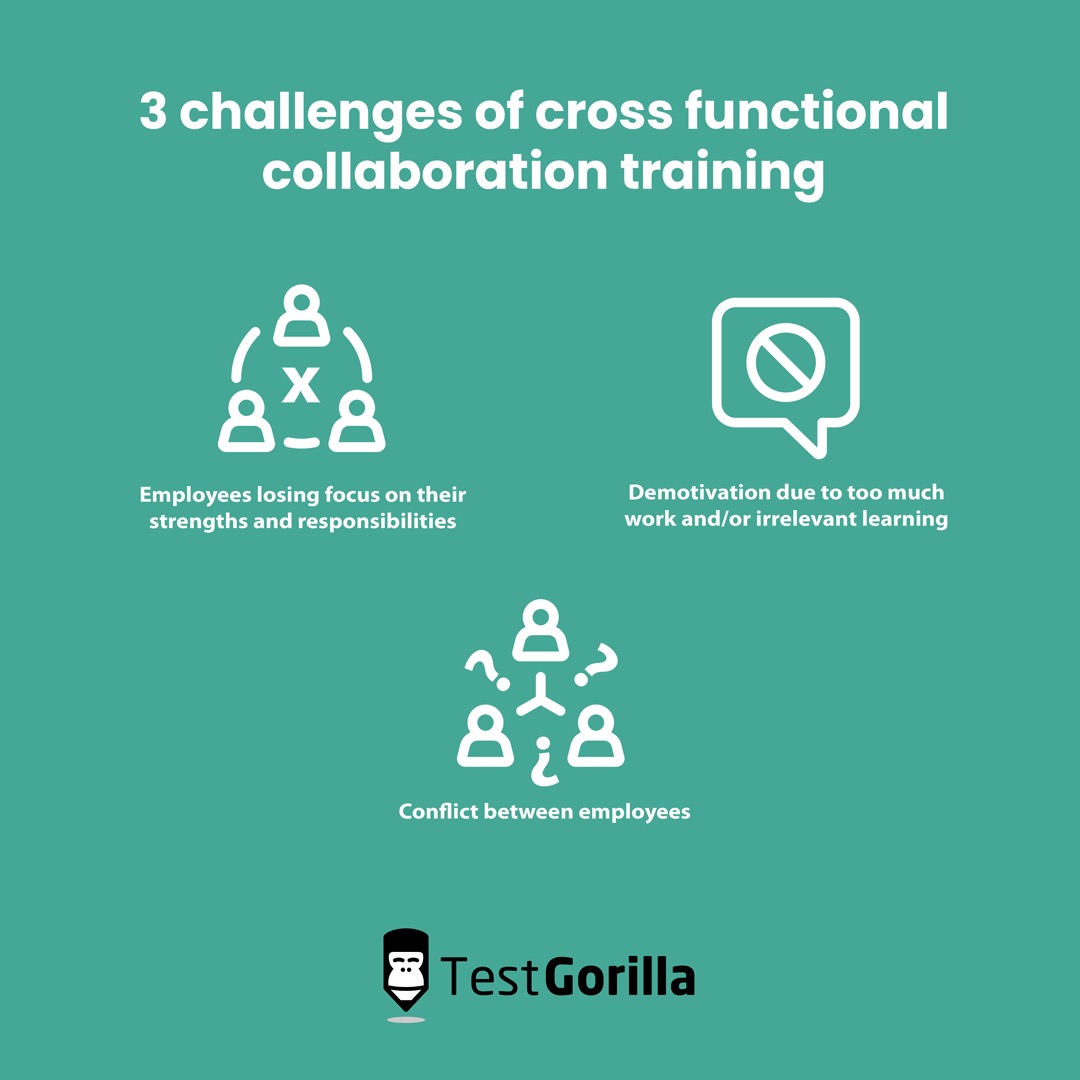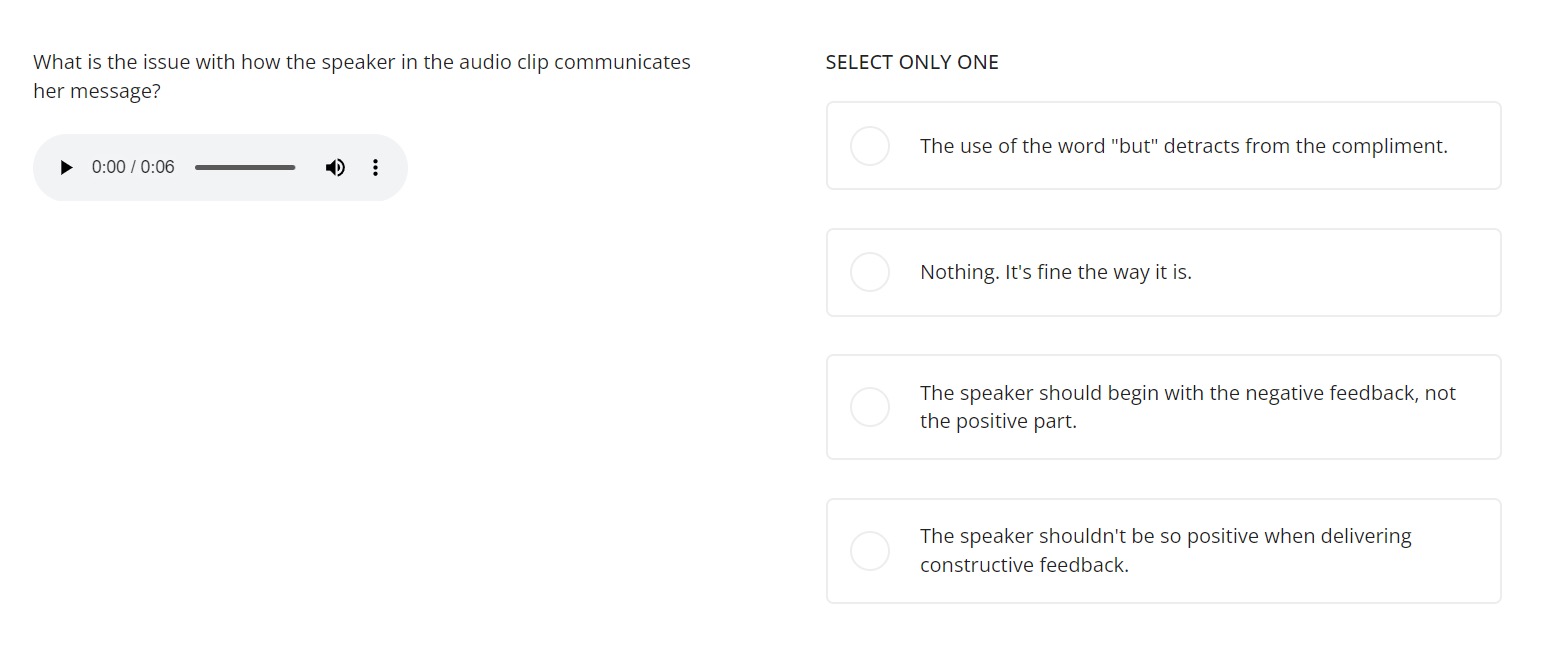Cross-functional training initiatives enable HR professionals to use internal networks, hone employees’ skills, and retain workers looking for challenges.
Instead of taking risks with new candidates or laying off good employees, you can expand your existing talent more fluidly to new roles. Other internal mobility benefits include higher engagement, agility, and innovation.
Cross-functional training is a great, organic way to become more mobile. Companies like Google, Apple, and Netflix are already on it.
This article discusses the top benefits and challenges of cross-functional training and the top strategies to get you started.
Table of contents
- What is cross-functional training in business?
- Why should you invest in cross training at work? The benefits
- The challenges of cross functional collaboration training
- How to get started with cross functional training: 6 best practices
- 3 cross functional training examples
- Cross functional training is a smart investment in your future
- Cross functional training FAQs
What is cross-functional training in business?
Cross-functional training or cross training is a talent development practice where you give employees opportunities to learn skills and knowledge that aren’t part of their current job description. This practice enables you to share skills and capabilities, break down silos, and build powerful working connections between team members.
The meaning of cross training at work is similar to job rotation, the practice of an employee moving to different departments inside the organization.
What is cross training in the workplace in a real-life scenario?
An IT specialist in database management may undergo work cross training in cybersecurity to combat database breaches and increase data security.
Why should you invest in cross training at work? The benefits
Why is cross training important?
Of the 50% of Americans who want to make career changes, 39% want a raise or promotion, and 33% want to switch industries.
Most of them leave their jobs to achieve this common goal, but they don’t have to if you have the right strategy.
The main advantages of cross training include using decision-making to give your people new opportunities, increase your company’s agility, and build strong future leaders.
Increased company resilience and agility
A large pool of employees with versatile skill sets is an investment in the future.
It gives you a more flexible workforce who can bounce across projects and departments, increasing your company’s resilience, agility, and employee retention. Cross-functional training lets you share skills across departments to strengthen overall knowledge and reduce the need for external support when dealing with production/service bottlenecks.
For example, a marketing expert can teach digital marketing practices to your content creators to strengthen conversions and drive traffic.
Talent sharing is one of the top reasons why agile, skills-based practices and employee development go hand-in-hand.
Goal alignment and better relationships across teams
Cross-training is a perfect opportunity to connect with everyone beyond Slack chatting and task comments.
It unites the workforce to move together toward the company’s goals instead of each department pulling its weight and focusing on its differences.
One of the benefits of cross-functional training is trust in the workplace and:
It’s an opportunity to socialize with colleagues and form better relationships
It provides a higher understanding of everyone’s responsibilities, leading to more empathy and better teamwork
A sense of belonging leads to lower turnover and higher performance
Great leadership training for future leaders
Cross functional training is an excellent part of your succession planning strategy. It’s a low-risk exercise to give future managers a preview of possible experiences, like talking with clients and handling conflict.
Future leaders can test their collaboration and communication skills with colleagues from other departments, not just their closest circle or team.
Leadership training enables you to develop motivated and trustworthy managers who show excellent potential and are familiar with the business instead of looking for a perfect candidate externally.
Skills gap prevention method
Skills gaps are an encroaching issue, and 87% of companies either already have or expect to have a skills gap within the next few years.
You have responsibilities to assign, and nobody has the qualifications to handle them within capacity. Rushed external hires or overloading current staff are risky ideas. A much safer option is a holistic talent strategy.
Cross training in the workplace helps build skills and bridge talent gaps, so your strategy can focus on building up internal talent.
Applying new skills leads to increased innovation
One of the less-known advantages of cross training is the boost in innovation.
Cross training staff develop skills they wouldn’t normally have built in their role, so once their training finishes, they return to their normal roles with new:
Hard and soft skills
Perspectives
Relationships and connections
Employees use these newly obtained resources naturally, leading to innovation that’s second nature. This approach also helps job crafting, with employees having more control over how they complete their responsibilities.
The challenges of cross functional collaboration training
Below are the main difficulties associated with cross functional training and our tips on overcoming them.
1. Employees losing focus on their strengths and responsibilities
Cross training in the workplace can get chaotic if you lose track of why you’re doing it, who’s involved, and what their primary goals are.
You must clarify responsibilities and ensure cross-functional training is focused and clear.
Tell employees which responsibilities to prioritize, starting with their current roles, and what to explore next.
2. Demotivation due to too much work or an irrelevant learning experience
You don’t want to overload staff by making everyone learn everything. Forcing employees to attend training they don’t want or need could damage their motivation and reduce job satisfaction.
Cross job training only makes sense when staff understand why they need it.
Explain to employees why continuous learning about a certain topic or gaining a new skill could help their current performance and which options open future doors to incentivize them.
3. Conflict between employees
Cross functional team training can stir conflict, including:
Competitive tendencies getting out of hand
Employees interpreting instructions or responsibilities differently
Staff being difficult to steer
These issues happen because of unclear communication and a lack of strong leadership.
Prepare communication channels and performance metrics ahead of time, and create a process or a standard operating procedure document that dispels uncertainty and encourages questions.
We also recommend your managers have cross-functional leadership skills in functional areas like business judgment and organization.
How to get started with cross functional training: 6 best practices
Cross-training employees is all about breaking the mold. This skills-based approach to the employee lifecycle is flexible and agile, so there are many ways to approach it. However, we have some great places for you to start.
Let’s look at how to implement cross training in the workplace using six powerful strategies.
1. Build a formal training structure to support your staff
Cross-training employees should be orderly and efficient. Nobody likes documentation, but a formal structure is necessary for consistent and reliable results.
Streamline your cross functional team training by defining:
What an employee needs to do
Whom to ask
Where to sign up
Which criteria to fulfill to get access to training or shadowing
A defined structure also helps support your employees.
When you cross train employees through upskilling or reskilling, they need support to focus on learning. Depending on the role’s complexity, they can’t take on all the responsibilities of their new role during their first week or even month.
You can also support your cross-training employees by letting them choose which types of training to attend. Only relevant courses should be mandatory.
Motivate workers to seek cross functional training that aligns with their career development plans so they have a personal investment in their growth.
2. Use talent assessments to identify talented individuals to focus on
Agile, collaborative employees with a drive to learn specific skills are the best candidates for cross-functional training, and you can zero in on them with talent assessments.
Gauge cross job training candidates with talent evaluations such as our Communication test to find people who thrive in a cross-functional environment.
If you’re interested in more sample questions, check out the Communication Skills test preview.
Skills tests are more reliable and accurate than judging a person by their resume. They set your cross job training up for success.
You can get started right away. Our Free Forever Plan contains unlimited access to the Communication, Motivation, and Problem Solving tests, which are all excellent for assessing cross-functional capability.
Talent assessments also help move employees cross-departmentally if they’re more suitable for another team.
Dyninno, a technology company, uses TestGorilla talent assessments to refer excellent candidates to other departments if they have skills that would benefit its teams.
3. Try cross functional coaching and mentoring schemes
Harnessing in-house expertise is an effective and affordable way to enhance employee skills.
Pairing employees with coaches provides amazing knowledge-sharing opportunities. A mentor is somebody with higher knowledge and expertise, like a senior engineer helping a junior engineer complete a code review.
Similarly, a coach is there to help employees overcome the learning curve. But they don’t necessarily have the knowledge they’re trying to obtain.
Rather, a coach’s expertise lies in navigating the learning journey itself so they can guide an employee through learning a skill they don’t possess yet.
Coaching and mentoring are common in skills-based hiring and skills-based practices. You can even build a solid coaching program into your onboarding process using the data from your talent assessment results.
Check out our product tour to see how the skills-based hiring process works.
4. Allow workers to go on secondments and try work shadowing in other departments to get on-the-job training
Employees who are familiar with the field they’re learning about and hands-on learners benefit from work shadowing and secondments. These techniques enable them to learn on the job alongside peers.
These activities can look like employees quietly sitting in on meetings, completing specific tasks, taking notes, practicing new skills in a controlled work environment, or even fully handling the responsibilities of their temporary role.
They also open the door for easy cross-boarding, which is moving an employee internally from one role to another.
Here are some scenarios where it makes sense to cross-board:
Scenario | Solution |
An employee needs a change | Move an employee into another position if they don’t feel challenged |
You have a skills gap in your company | Try closing the gap internally before you turn to the external market |
A job role is going through changes or is slowly becoming obsolete | Cross train employees and transfer them to new roles |
5. Focus on the cross-functional training experience, not just performance
Cross training at work isn’t just about an employee’s performance in their new role. The experience should be enjoyable and satisfactory to give them a return on investment for their participation.
A positive cross job training program increases employee engagement, adaptability, and versatility and builds corporate reputation.
After you begin cross-training employees, ask yourself:
Were employees engaged?
Did they learn the skills they hoped they’d learn?
Did they build meaningful relationships?
Were they overly stressed or frustrated?
Answering these questions improves employee satisfaction and helps you build a stronger, more effective cross functional team training program.
6. Tie cross functional training into your succession planning efforts
Cross training in the workplace is perfect for succession planning strategies.
When you build cross-functional training into succession planning, it helps:
Make transitions smoother for the company and unnoticeable to clients and customers
Prevent chaos when a critical employee suddenly exits
Ensure key knowledge reaches the next person in line instead of leaving a gap in the business that’s hard to fill later
We recommend you use talent assessments to understand your exiting employee’s skills and have accurate, reliable data on how to fill the role successfully.
When the day comes, you can focus on giving the employee a proper goodbye, knowing your business is still in good hands, instead of relying on rushed external hiring.
3 cross functional training examples
For inspiration, let’s look at a few real-life cross training examples and case studies.
Cross-train examples | Key points |
IDEO | - Executed a cross-functional training program built around people - Evaluated employees to find key cross job training skills, such as empathy and learning agility - Relied on skills and looked beyond resumes |
Northwestern Mutual | - Promoted fresh ideas by avoiding siloed teams - Combined financial, investment, and actuarial departments into a successful cross-functional team - Pushed itself ahead of the curve by building one of the first information system departments by cross training staff - Spread cross-functional teams across every area of the organization |
Apple | - Promoted a leadership model that encouraged every member to contribute - Streamlined operations by relying on cross-departmental collaboration - Built the iPhone using a cross-functional team of experts |
Other companies that use cross training in the workplace and have permanent cross-functional teams include Amazon, Facebook, Cisco, and Nokia.
Cross functional training is a smart investment in your future
Cross training in the workplace is a great way to prepare and become resilient even to factors outside your control – like global trends or technological advancements. It helps you maximize your resources and optimize your talent for the future.
Start by gauging your cross-training employees using our talent assessments. Sign up for our Free Forever Plan to get unlimited access to vital cross-functional training skills like communication and problem-solving.
You can also hop over to our product tour for a step-by-step guide on how to use talent assessments for your training and succession planning efforts.
Or, if you prefer a guided approach, book a demo to get an in-depth look at TestGorilla with one of our friendly experts.
Cross functional training FAQs
Let’s finish this up by answering a few frequently asked questions.
What are cross-functional skills?
Cross-functional training requires excellent communication, problem-solving, motivation, conflict resolution, teamwork, and critical thinking skills. It’s also beneficial to have learning agility and an ever broader skill set, called a multipotentialite or a jack-of-all-trades.
How do you facilitate cross-functional work?
Set clear goals
Define roles and select employees with the right skills
Consider available resources
Determine how your team works together
Establish a strong leadership style
Communicate consistently
Check out our best practices above for how you can facilitate cross training at work.
What is another name for a cross-functional team?
Cross-functional teams are also known as multidisciplinary, interdisciplinary, or interdepartmental teams. They refer to colleagues with different skills and competencies working together toward the same goal.An example would be marketing, sales, and customer success collaborating on cross-functional teams.
For a few more ideas, check out our cross training examples above.
What is an example of cross-training in the workplace?
Cross training at work is when you place employees in different roles to teach them new skills. An example of work cross training is an employee from finances working in human resources to broaden their payroll knowledge. Cross-functional training happens alongside an employee’s current role, which means the above employee can apply their new financial skills to their usual position.
See some more cross-train examples earlier in this blog post.
Is cross functional training related to cross boarding?
Cross-functional training is a fundamental part of the cross boarding process. Cross boarding is when companies hire internally. Cross training at work helps these employees prepare for their new roles in a hands-on approach. Internal candidates have valuable company knowledge, but the rules that apply to external recruitment also apply here. The right person must have an adequate skill set and personality to succeed in different roles.
What are the cons of cross-training?
Cross-training employees may feel pressured and stressed from juggling multiple responsibilities and roles, especially when you don’t create a structured cross job training program. You must understand your goals and expectations to ensure your cross training staff isn’t overwhelmed.
Related posts
Hire the best candidates with TestGorilla
Create pre-employment assessments in minutes to screen candidates, save time, and hire the best talent.
Latest posts
The best advice in pre-employment testing, in your inbox.
No spam. Unsubscribe at any time.

Hire the best. No bias. No stress.
Our screening tests identify the best candidates and make your hiring decisions faster, easier, and bias-free.
Free resources
This checklist covers key features you should look for when choosing a skills testing platform
This resource will help you develop an onboarding checklist for new hires.
How to assess your candidates' attention to detail.
Learn how to get human resources certified through HRCI or SHRM.
Learn how you can improve the level of talent at your company.
Learn how CapitalT reduced hiring bias with online skills assessments.
Learn how to make the resume process more efficient and more effective.
Improve your hiring strategy with these 7 critical recruitment metrics.
Learn how Sukhi decreased time spent reviewing resumes by 83%!
Hire more efficiently with these hacks that 99% of recruiters aren't using.
Make a business case for diversity and inclusion initiatives with this data.





















